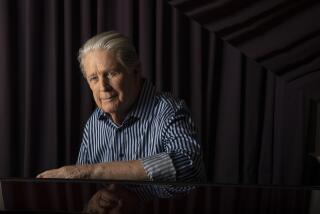Apocalypse Is Here, and It’s Gorgeously Inviting
- Share via
NEW YORK — Robert Wilson’s latest theatrical spectacle/opera, “The Days Before: death, destruction and detroit III,” which was among the opening events of Lincoln Center Festival 99 last week, is magic.
The lighting is gorgeous beyond all description--background colors, subtle and vivid, and precise spots of luminous white light induce figures and properties to glow as if divinely lit. An oddly beguiling vision of the Apocalypse, a world is created, surreal yet pleasantly serene, disorienting yet utterly natural.
Actors and dancers from many nations and many traditions glide on and off stage, each a surprise, each a delight. A Tibetan singer and a warbling 90-year-old Turkish Isolde happily coexist, as does, say, Tony Randall reading a sophisticated text by the Italian novelist and semiotician Umberto Eco, and the curiously poetic jibber-jabber of Wilson regular Christopher Knowles, deconstructing Barry Manilow’s song “Mandy.” “This is this, that is that,” Knowles says over and over, followed by a studied, nervous laugh, and the audience is enchanted. Ryuichi Sakamoto, the Japanese pop musician and film composer, seduces the ear with glittery electronics.
As Lincoln Center has been proudly announcing, “The Days Before” is the first new work in 15 years that Wilson has created for New York, although Lincoln Center and BAM often import productions from elsewhere. But it is a more telling statistic than that: The 1986 piece was but a modest production of Heiner Muller’s “Hamletmachine” with students at New York University. In fact, Wilson has not made new work of any scale or importance for New York since his experimental, all-night “silent” operas prior to his famous collaboration with composer Philip Glass for “Einstein on the Beach,” which was created for the Festival d’Avignon in France in 1976.
Paris, on the other hand, has seen at least one significant new Wilson production every year for the past two decades. Europeans talk about opera before Wilson and after Wilson. In the United States, Wilson, a Texan fluent only in English and a quintessentially American artist, is an exotic, completely outside the mainstream of American theater and opera.
“The Days Before” comes to New York without context. It is a continuation of two previous parts of “Death Destruction & Detroit” which were made for Berlin in 1979 and 1986. The first was a five-hour mediation on the then-incarcerated Hitler aide Rudolf Hess, as the man who refused to die; the second, which began with a woman breaking pencil after pencil until she had a large pile of pieces, was inspired by Kafka, the man who refused to live. “The Days Before” places life and death in a new, millennial revelation of destruction and reconstruction. A rooster proclaims the end is near; an owl doubts it. The text is taken from Eco’s novel “The Island of the Day Before,” in which a 17th century shipwrecked nobleman ponders the meridian that divides time into today and the day before.
There is a sleekness to “The Day Before.” It is relatively short, cut down from 200 minutes in workshop to an intermissionless 100 in the version seen at the New York State Theater in its final performance Saturday night. Each of the 12 scenes is a tightly knit unit of images with an apocalyptic theme--Judgment Day, a chess game with Death, a classroom of fallen angels, a sinking passenger liner. And each scene includes an unrelated text drawn from Eco’s novel read by actress Fiona Shaw. Along with Randall, Isabella Rossellini and Jeremy Geidt are also briefly enlisted as guest readers.
In one scene, the Romanoffs die at the hand of Japanese dancers, whose stylized movement is choreographed by Suzushi Hanayagi and whose avant-garde samurai outfits are designed by Jacques Reynaud. Portraits of the Czar and his family, still and from documentary films, are projected on elegant transparent screens. A text about islands is read. The background music provides a haunting Satie-sque atmosphere. The murder is courtly and abstract, with the world seeming not to notice. The mood is one of profound melancholy.
For Wilson, everything in theater is independent. Images, text, music, movement, light, design, individual styles of acting needn’t coordinate to coexist. He looks and listens to the world, taking in everything at once. While much of our culture, from movies to novels, from Broadway shows to symphonies, strives to be conventionally explicable, Wilson’s work reveals rather than reasons. God, for him, is very much in the details, and the details of the “The Days Before” are stunning.
But Wilson--now a master organizer juggling numerous international projects with the help of a coterie of assistants and acolytes--doesn’t seem quite as free with time as he once was. Nothing goes on too long in “The Days Before,” even though going on too long, getting past boredom (often with the help of a small snooze) and awaking into a state of newly heightened awareness, was always what made Wilson seem so special. In the first “Death Destruction & Detroit,” a giant lightbulb seemed to glow forever as if a representation of Hess who wouldn’t go away.
In “The Days Before,” everything seems to fade, often before it can sink in. But, then, maybe that is precisely the apocalyptic point at this millennium’s end, when everything else in life is accelerating.
More to Read
The biggest entertainment stories
Get our big stories about Hollywood, film, television, music, arts, culture and more right in your inbox as soon as they publish.
You may occasionally receive promotional content from the Los Angeles Times.











